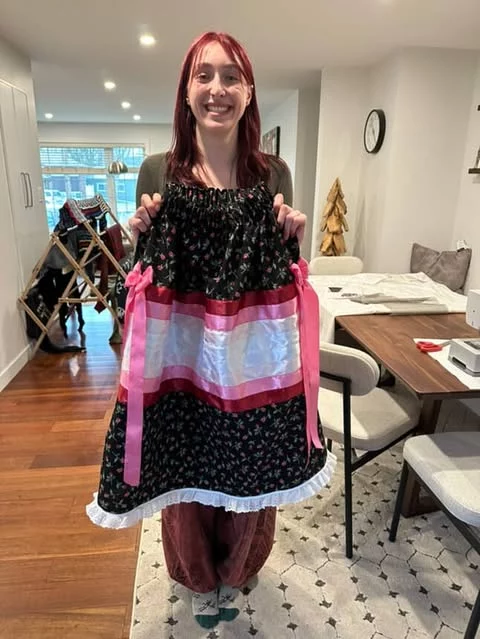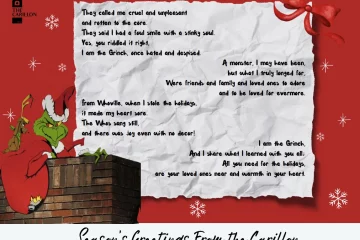Sustainable, colourful, and suitable for every temperature
While sitting down with the Carillon, Ginny Eger recently shared her journey in making ribbon skirts and how this one item of clothing can change the way you think about your wardrobe. Eger is currently a first year Métis student in the Saskatchewan Urban Native Teacher Education Program (SUNTEP) at the Gabriel Dumont Institute. She is also on the varsity ultimate team of the University of Regina (UofR) Cougars. Outside of the classroom and off the field, she can be found with her sewing machine, making colourful projects and intricate garments.
Childhood & learning to sew
Growing up, Eger would often sew alongside the women in her family. “My sister and I would go out to [my grandparents’] cabin a lot,” said Eger. “She would do a lot more sewing with our grandma. I [could do] the basic straight stitch, then [I would get] bored and [go] to the garage with my grandfather.”
As a child, her beginner sewing projects typically started out with making rags. “I could sew a line but I wouldn’t say I was [really] sewing,” said Eger. Later, she started practicing on the machine and hand sewing. It was back in April of 2022 that she got into making ribbon skirts.
“I came back from an Indigenous program in Manitoba and I really wanted to make one,” she shared. “We went to ceremony everyday and everyone had ribbon skirts. I didn’t have any [back] then. When I came home, I [wanted] to have one.”
By borrowing a book on Métis Ribbon Skirts from the ta-tawâw centre and taking advantage of her background with sewing, she began her first skirt project with the help of her mother. “My mom can sew really well. [She] taught me all the different stitches and the fancy hanging ribbons. [It] was all just trial and error.”
Figuring out the basics of the sewing machine and how to troubleshoot the problems was a major inconvenience that Eger learned to overcome. In the beginning, she found herself getting frustrated over the machine jamming or a material getting stuck. “I would have to continuously call my mom to come fix it, [but] once I got over that, I was good,” she confessed.
They’re pretty nice and airy, I can wear leggings [underneath] during winter and […] they don’t overheat like wearing a pair of pants [in the summer]. -Ginny Eger
Teaching the craft
Over the summer, Eger had the opportunity to teach a ribbon skirt class at Mother Teresa Middle School, where she worked with students who have never used a sewing machine. She was full of joy seeing the kids wear their ribbon skirts, but the most rewarding part for Eger was watching her students troubleshoot the sewing machine together.
“[They] help[ed] each other when the bobbin [gets] stuck, when everything [gets] jammed up, instead of immediately coming to me,” she expressed. Eger shared how proud she was with how quick the students were able to soak up her teachings. “By the second day, [they were] fully able to work the sewing machines by themselves [and] were rethreading everything. It was crazy!”

Custom orders & sustainability
Recently, Eger launched @bear_paw_ribbons on Instagram and started accepting orders of both ribbon skirts and ribbon shirts. Custom orders can be done by sending a direct message to the account. One can ask for their chosen colours, pattern, material, and ribbons to be used.
Eger uses a 100 per cent cotton base for all of her projects and double faced satin ribbons. Sustainability is a priority in her craft, so one can be assured that nothing goes to waste in her production of orders. Fabric scraps from previous projects are used for making pockets. The pockets of Eger’s own ribbon skirt that she had worn during this conversation had leftover scraps from her niece’s skirt.
She keeps a box of left-over ribbons that get turned into toy ribbon skirts and the threads are used until the spool is clean. Some of the scraps were even used by her students to practice running material through a machine. “[All] materials [have] something I can use [them] for. It comes in handy, especially for the random stuff you need that you don’t think about,” she said.
When sewing, Eger tends to go on auto-pilot mode, but one can find her listening to music that resonates with the garment she is making. “I’ve made a skirt based on a character from The Lord of the Rings, so I [listened] to the soundtrack on repeat,” she shared. Her favourite feedback she has received from a customer came from the Indigenous advocate at Mother Teresa Middle School. He praised how quickly the order was done and how the elements she had incorporated onto his ribbon shirt had meaning to him. “He said he was going to be proud to wear it for his speech the next day, for National Indigenous Day,” said Eger.
Sustainability is a priority in [Eger’s] craft, so one can be assured that nothing goes to waste in her production of orders. – Lee Lim
Sharing the joy of her craft
Eger’s love for wearing ribbon skirts comes out of wanting to represent her Indigenous culture and because of what the skirt offers for style. “You can make them look very professional [so it’s] great if you want to look put together,” she said.
Aside from presenting well in a number of settings, the skirt also offers comfort and all-season wearability. “They’re pretty nice and airy, I can wear leggings [underneath] during winter and […] they don’t overheat like wearing a pair of pants [in the summer],” she affirmed. The ability to easily match with a friend or loved one is another perk of wearing ribbon skirts. “My partner has a few navy and maroon [clothes], so I’m able to just put on […] a dark blue or red skirt [to] match. I like doing that with him,” Eger shared.
She encourages non-Indigenous people to wear ribbon skirts, as long as they are wearing them with respect. She urges those that are interested in wearing one to purchase them from non-fast fashion sellers.
“Wear them for Orange Shirt Day or Indigenous Peoples Day. Represent, even if it’s not for yourself. People will ask where you got that and [you can say] you ordered it from this person or [you] took a class. Stuff like that still spreads awareness.”
Eger hopes that everyone gets to experience wearing a ribbon skirt with a material that resonates with them, and wishes to start integrating more techniques like beading into her work. She wants to venture out of her comfort zone more and plans to make her six-foot-four father an apron that can fit him, and to someday make a fancy dress to dance in and bring her garments out to some markets in the future.







